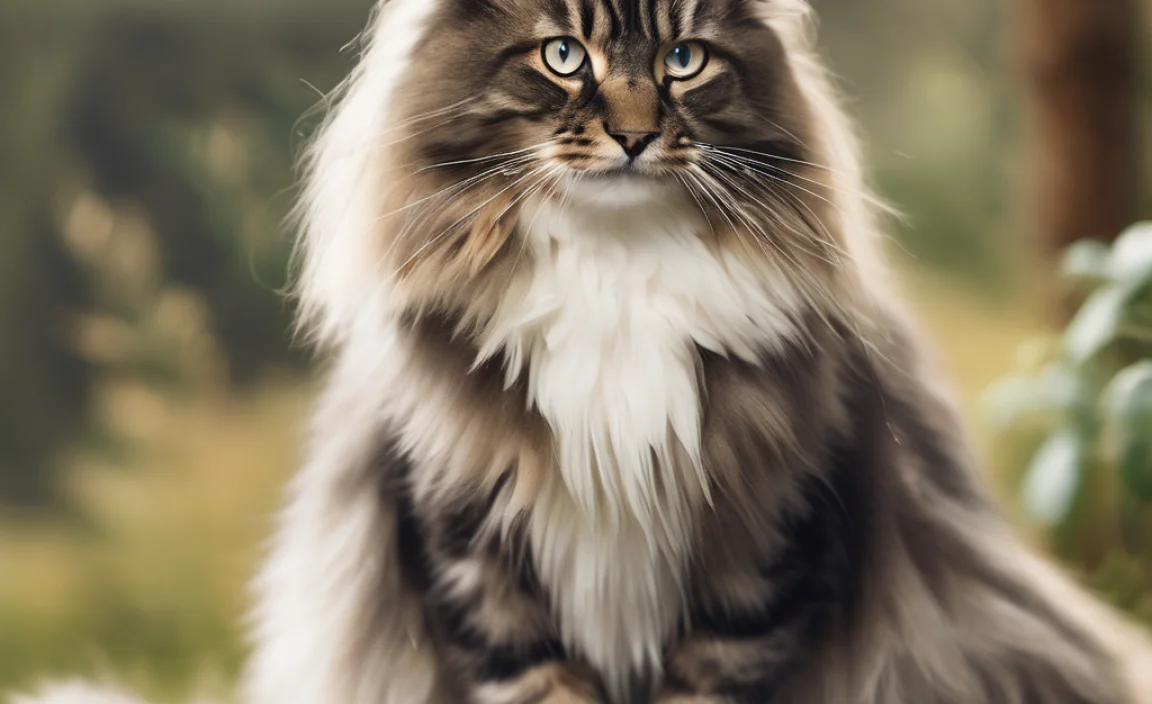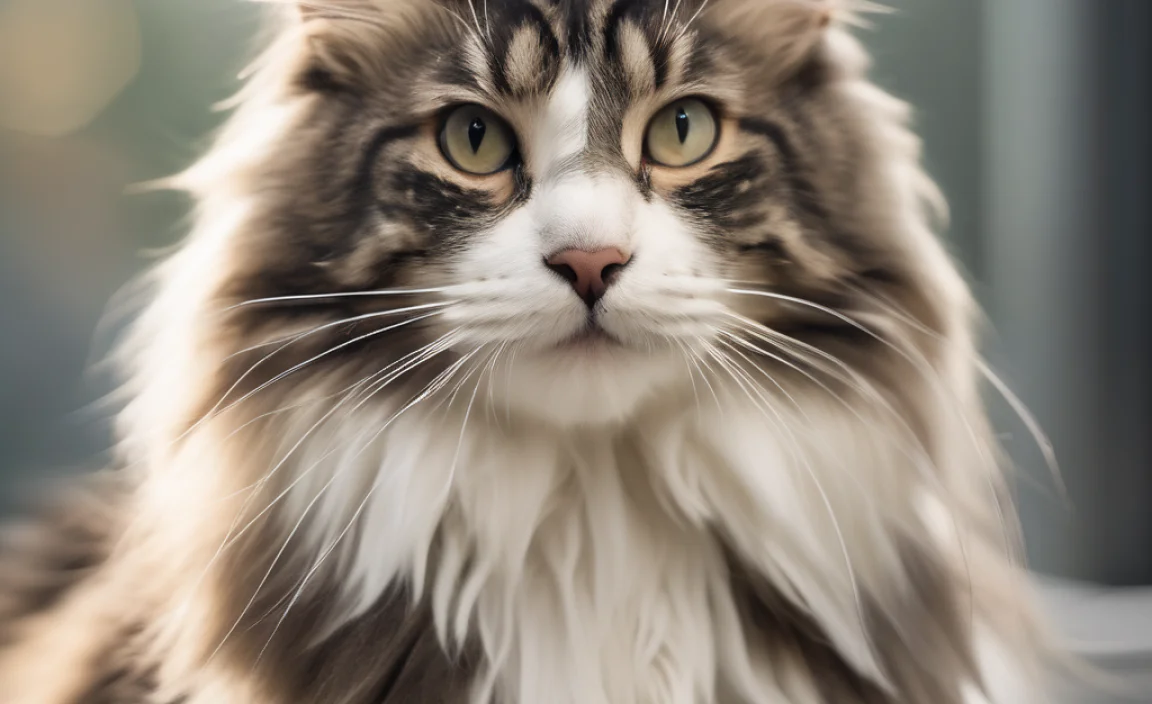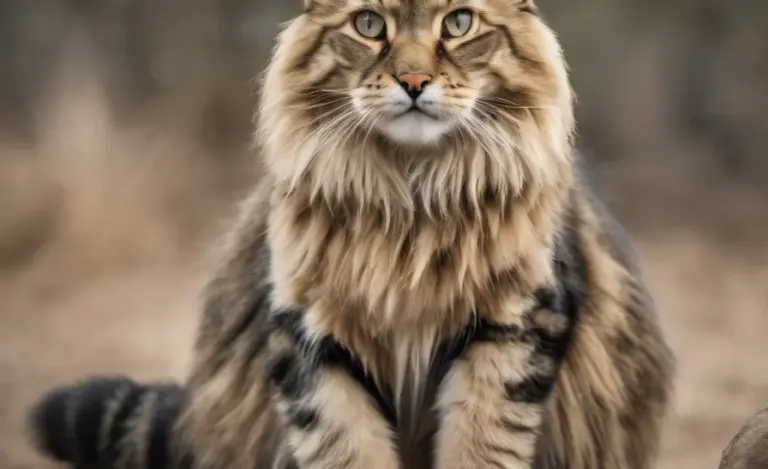Timeline of Norwegian Forest Cat: [Ultimate] Guide
Quick Summary: The Norwegian Forest Cat, or “Wegie,” has a unique life journey! From kittenhood (0-6 months), they grow quickly, needing lots of play and good food. As adolescents (6-18 months), they reach their full size and mature. Adults (1.5-10 years) are active and playful. Senior Wegies (10+ years) slow down but still enjoy love and care. Knowing this timeline helps you give your furry friend the best life!
Have you ever wondered what to expect as your Norwegian Forest Cat grows? It’s a common question! These beautiful cats have a special timeline, from tiny kittens to wise seniors. Understanding each stage helps you give them the best care. Don’t worry, it’s not complicated!
This guide will walk you through each step. We’ll cover kittenhood, adolescence, adulthood, and the senior years. You’ll learn what to expect and how to support your Wegie at every age. Let’s get started!
The Norwegian Forest Cat: A Breed Overview

Before we dive into the timeline, let’s quickly introduce the Norwegian Forest Cat. These cats are known for their large size, thick fur, and gentle nature. They originated in Norway and are built to withstand cold climates. According to The International Cat Association (TICA), they are friendly and adaptable, making them great family pets.
Wegies are intelligent and playful. They enjoy climbing and exploring. Their thick fur requires regular grooming to prevent mats and tangles. Understanding their breed characteristics helps you appreciate their unique timeline.
Timeline of a Norwegian Forest Cat: From Kitten to Senior

The life of a Norwegian Forest Cat can be divided into four main stages: kittenhood, adolescence, adulthood, and senior years. Each stage has its own characteristics and care needs. Let’s explore each one in detail.
Kittenhood (0-6 Months)
Kittenhood is a time of rapid growth and development. Your Wegie kitten will change a lot in these first few months. Here’s what to expect:
- 0-8 Weeks: Kittens are completely dependent on their mother. They need warmth, food, and socialization. Reputable breeders usually keep kittens with their mothers until at least 8 weeks.
- 2-4 Weeks: Eyes open, and kittens start to explore their surroundings. They begin to walk and play with their littermates.
- 4-6 Weeks: Weaning begins, and kittens start eating solid food. Introduce high-quality kitten food.
- 6-12 Weeks: Kittens become more independent and playful. They need lots of toys and interaction. This is a critical time for socialization.
Caring for Your Kitten:
- Nutrition: Feed a high-quality kitten food. Look for food that is specifically formulated for kittens.
- Veterinary Care: Regular vet checkups and vaccinations are essential. Follow your vet’s recommendations for deworming and flea prevention.
- Socialization: Expose your kitten to different sights, sounds, and people. This helps them grow into well-adjusted adults.
- Play: Provide plenty of toys and playtime. Wegie kittens are active and need to burn off energy.
Adolescence (6-18 Months)
Adolescence is a transitional period. Your Wegie will continue to grow and mature. Here’s what to expect:
- Physical Growth: Wegies reach their full size during this stage. They may still fill out and gain muscle mass.
- Behavioral Changes: Adolescents may become more independent and assertive. They may also exhibit more playful or even slightly rebellious behaviors.
- Sexual Maturity: Cats typically reach sexual maturity around 6-9 months. Spaying or neutering is recommended to prevent unwanted litters and certain health problems. The RSPCA recommends spaying or neutering around four months old.
Caring for Your Adolescent Wegie:
- Nutrition: Continue feeding a high-quality cat food. You may need to adjust the amount as your cat’s activity level changes.
- Training: Reinforce good behaviors with positive reinforcement. Consistency is key.
- Enrichment: Provide plenty of opportunities for play and exploration. Cat trees, scratching posts, and puzzle toys are great options.
- Grooming: Regular grooming is essential to prevent mats and tangles. Brush your Wegie several times a week.
Adulthood (1.5-10 Years)
Adulthood is the prime of your Wegie’s life. They are typically healthy and active during this stage. Here’s what to expect:
- Physical Condition: Adult Wegies are strong and muscular. They maintain a healthy weight with proper diet and exercise.
- Behavior: Adults are typically well-behaved and affectionate. They enjoy spending time with their families.
- Activity Level: Wegies remain active and playful throughout adulthood. They enjoy climbing, exploring, and playing with toys.
Caring for Your Adult Wegie:
- Nutrition: Feed a high-quality adult cat food. Monitor your cat’s weight and adjust the amount as needed.
- Veterinary Care: Annual vet checkups are important for maintaining your cat’s health. Your vet can screen for common health problems.
- Enrichment: Continue to provide opportunities for play and exploration. Rotate toys to keep your cat interested.
- Grooming: Regular grooming is essential to prevent mats and tangles. Pay special attention to areas prone to matting, such as the undercarriage and behind the ears.
Senior Years (10+ Years)
Senior cats require extra care and attention. As your Wegie ages, they may experience changes in their physical and cognitive abilities. Here’s what to expect:
- Physical Changes: Senior cats may experience decreased mobility, weight loss, and changes in appetite. They may also develop age-related health problems, such as arthritis and kidney disease.
- Behavioral Changes: Seniors may become less active and more withdrawn. They may also experience cognitive decline, leading to confusion and disorientation.
- Health Issues: Senior cats are more prone to certain health problems, such as kidney disease, heart disease, and diabetes. Regular vet checkups are essential for early detection and treatment.
Caring for Your Senior Wegie:
- Nutrition: Feed a high-quality senior cat food. Senior diets are often lower in calories and higher in fiber.
- Veterinary Care: Biannual vet checkups are recommended for senior cats. Your vet can monitor your cat’s health and address any age-related issues.
- Comfort: Provide a comfortable and supportive bed. Make sure your cat has easy access to food, water, and the litter box.
- Gentle Exercise: Encourage gentle exercise to maintain muscle mass and mobility. Short walks or play sessions can be beneficial.
- Mental Stimulation: Provide mental stimulation to prevent cognitive decline. Puzzle toys and interactive games can help keep your cat’s mind sharp.
Key Milestones in a Norwegian Forest Cat’s Life

Here’s a table summarizing the key milestones in a Norwegian Forest Cat’s life:
| Age | Milestone | Care Tips |
|---|---|---|
| 0-6 Months | Rapid Growth, Socialization | High-quality kitten food, vet visits, lots of play. |
| 6-18 Months | Reaching Full Size, Sexual Maturity | Continue high-quality food, training, enrichment. |
| 1.5-10 Years | Adulthood, Peak Activity | Adult cat food, annual vet checkups, regular grooming. |
| 10+ Years | Senior Years, Potential Health Issues | Senior cat food, biannual vet visits, comfortable environment. |
Common Health Concerns at Different Ages

Like all breeds, Norwegian Forest Cats are prone to certain health issues. Knowing these can help you provide the best care. The Cornell Feline Health Center is a great resource for learning more about feline health.
- Kittens: Upper respiratory infections, parasites (worms, fleas), congenital issues.
- Adults: Hypertrophic cardiomyopathy (HCM), hip dysplasia, pyruvate kinase deficiency (PKD).
- Seniors: Kidney disease, arthritis, diabetes, hyperthyroidism.
Regular vet checkups can help detect and manage these conditions early. Discuss any concerns with your veterinarian.
Adjusting Your Care Based on Age

Your Wegie’s needs will change as they age. Here’s how to adjust your care:
- Nutrition: Switch to age-appropriate food. Kittens need more calories and protein, while seniors need fewer calories and more fiber.
- Exercise: Adjust the intensity and duration of exercise. Kittens need lots of play, while seniors may prefer gentle walks.
- Environment: Make sure your home is safe and comfortable. Provide soft beds, easy access to food and water, and a quiet space to rest.
- Veterinary Care: Increase the frequency of vet checkups. Seniors need more frequent monitoring for age-related health problems.
Creating a Safe and Stimulating Environment
A safe and stimulating environment is essential for your Wegie’s well-being. Here are some tips:
- Cat-Proofing: Remove hazards such as poisonous plants, toxic chemicals, and small objects that could be swallowed.
- Vertical Space: Provide cat trees, shelves, and window perches. Wegies love to climb and explore.
- Scratching Posts: Offer a variety of scratching posts. This helps your cat groom their claws and stretch their muscles.
- Toys: Rotate toys regularly to keep your cat interested. Puzzle toys, interactive games, and simple toys like balls and mice are all great options.
- Safe Hiding Places: Provide safe hiding places where your cat can retreat when they feel stressed or overwhelmed. Cardboard boxes, covered beds, and quiet corners are all good options.
Grooming Needs at Different Life Stages
Norwegian Forest Cats have thick fur that requires regular grooming. Here’s how grooming needs change at different life stages:
- Kittens: Gentle brushing to get them used to the sensation. Focus on bonding and making grooming a positive experience.
- Adolescents: Regular brushing to prevent mats and tangles. Pay attention to areas prone to matting, such as the undercarriage and behind the ears.
- Adults: Consistent brushing schedule (several times a week). Occasional baths as needed.
- Seniors: More frequent, gentle brushing. Seniors may be less able to groom themselves, so extra care is needed.
Regular grooming helps prevent mats, reduces shedding, and allows you to check for any skin problems or lumps.
Recognizing Signs of Aging and When to Seek Veterinary Care
It’s important to recognize the signs of aging in your Wegie and know when to seek veterinary care. Here are some common signs:
- Decreased Activity: Your cat may sleep more and play less.
- Weight Loss: Your cat may lose weight despite eating normally.
- Changes in Appetite: Your cat may eat more or less than usual.
- Stiffness or Lameness: Your cat may have difficulty moving around.
- Changes in Litter Box Habits: Your cat may urinate or defecate outside the litter box.
- Cognitive Decline: Your cat may seem confused or disoriented.
If you notice any of these signs, schedule a vet appointment. Early detection and treatment can improve your cat’s quality of life.
Frequently Asked Questions (FAQ)
Here are some frequently asked questions about the timeline of a Norwegian Forest Cat:
- Q: How long do Norwegian Forest Cats typically live?
- A: Norwegian Forest Cats typically live for 12-16 years, but some can live even longer with good care.
- Q: When is a Norwegian Forest Cat considered a senior?
- A: Norwegian Forest Cats are generally considered seniors around 10 years of age.
- Q: How often should I groom my Norwegian Forest Cat?
- A: You should groom your Norwegian Forest Cat several times a week to prevent mats and tangles.
- Q: What kind of food should I feed my Norwegian Forest Cat?
- A: Feed a high-quality cat food that is appropriate for your cat’s age and activity level. Look for food that is rich in protein and low in carbohydrates.
- Q: How much exercise does a Norwegian Forest Cat need?
- A: Norwegian Forest Cats are active and need plenty of exercise. Provide opportunities for climbing, exploring, and playing with toys.
- Q: Are Norwegian Forest Cats prone to any specific health problems?
- A: Yes, Norwegian Forest Cats are prone to certain health problems, such as hypertrophic cardiomyopathy (HCM), hip dysplasia, and pyruvate kinase deficiency (PKD). Regular vet checkups can help detect and manage these conditions early.
- Q: When should I spay or neuter my Norwegian Forest Cat?
- A: It is generally recommended to spay or neuter your Norwegian Forest Cat around 4-6 months of age, according to the RSPCA. Consult with your veterinarian for the best timing for your cat.
Conclusion
Understanding the timeline of your Norwegian Forest Cat is essential for providing the best possible care. From the rapid growth of kittenhood to the golden years of seniority, each stage has its own unique needs. By providing proper nutrition, veterinary care, enrichment, and grooming, you can help your Wegie live a long, healthy, and happy life. Remember to adjust your care as your cat ages, and always consult with your veterinarian if you have any concerns. With love and attention, your Norwegian Forest Cat will be a cherished member of your family for many years to come.




